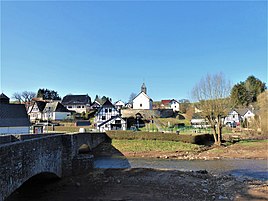Ahrdorf
|
Ahrdorf
Municipality Blankenheim
Coordinates: 50 ° 22 ′ 22 ″ N , 6 ° 46 ′ 39 ″ E
|
||
|---|---|---|
| Height : | 340 (330-350) m | |
| Area : | 5.3 km² | |
| Residents : | 240 (December 31, 2003) | |
| Population density : | 45 inhabitants / km² | |
| Incorporation : | 1st July 1969 | |
| Postal code : | 53945 | |
| Area code : | 02697 | |
|
Location of Ahrdorf in North Rhine-Westphalia |
||
|
View of Ahrdorf
|
||
Ahrdorf is a district of the municipality Blankenheim (Ahr) in the district of Euskirchen in North Rhine-Westphalia . The place is about two kilometers before the crossing of the Ahr into the state of Rhineland-Palatinate .
history
Ahrdorf, first mentioned in a document in 970 under the name Aredorph (975 Aredorff, 1588 Aerendorp), belonged to the parish of Üxheim in the Cologne “Eifeldekanat”, which is now in Rhineland-Palatinate . Under French administration , Ahrdorf was assigned to the Uedelhoven parish in 1803 and belonged to the Trier diocese . In March 1825 the parish of Uedelhoven and Ahrdorf came to the Archdiocese of Cologne ; since 1930 the parish has belonged to the re-established diocese of Aachen .
The small town, which had only 15 houses in 1687 and 21 in 1740, was a political curiosity in the feudal period (before 1794) because, as an exclave, it was completely surrounded by foreign territories; In the west, north and south these were the domains of the Duchy of Arenberg , in the east the villages of Müsch and Hoffeld belonging to the Electorate of Cologne and in the southeast the places Trierscheid and Nohn of the Electorate of Trier . The transfer to “abroad” took place shortly after the village border.
As a result of the French Revolution and the occupation of the Left Bank of the Rhine by French troops, Ahrdorf became part of the Mairie Lommersdorf in the canton of Blankenheim in 1798 as a municipality . With this, it came as a result of the Vienna Congress of Prussia and was in 1816 part of the circle Blankenheim in the administrative district of Aachen the Rhine province .
While the Blankenheim district was merged into the enlarged Gemünd district as early as 1818 (Schleiden district from 1829), the Ahrdorf community remained in existence until July 1, 1969. As part of the Blankenheim office, it merged into the newly formed Blankenheim community.
The Ahrdorf (Ahr) train station gained temporary importance as a junction between two railway lines that were primarily built for military reasons:
- Railway line Dümpelfeld – Lissendorf : Dümpelfeld - Ahrdorf (Ahr) - Hillesheim (Eifel) - Lissendorf (- Jünkerath). Opening: July 1, 1912, shutdown : 1973
- Ahrdorf – Blankenheim railway line : Ahrdorf (Ahr) - Blankenheim (Wald). Start of construction: April 1, 1910, opening: May 2, 1913, (partial) closure: March 3, 1961
The Ahrdorf tunnel built to integrate the last-mentioned route dominated the silhouette of Ahrdorf until the 1970s. Due to its poor state of preservation, it had to be filled in. The buildings of the Ahrdorf (Ahr) train station, located one kilometer below the town in the Ahbachtal , were sold after the line was closed and since then u. a. used for rehearsals for recordings ( BAP : "For usszeschnigge!", 1981). The cover of the BAP album Vun drinne noh drusse shows a night shot of the freight hall of the former train station.
Attractions
- The St. Hubertus Chapel , consecrated to St. Hubert (8th century Brabantine bishop), is essentially a church belonging to the early Middle Ages (11th / 12th centuries) . The quarry stone building is still the defining building in the center of the village.
Several in quarry stone , occasionally also half-timbered, executed houses and mills, mostly from the 18th and 19th centuries, including:
- Plotzenhof ( manor complex probably from the last quarter of the 18th century)
- Obere Ahrdorfer Mühle (Blums-Mühle) as well as the younger one
- Lower Ahrdorfer mill from 1818 (former. Jakob mill, now Fring mill) with adjoining campsite
- Building of the former Ahrdorf (Ahr) train station , from 1910–1911
Events
- The popular “ soap box race ” has been held annually since 1975 - albeit with an interruption from 1982–2002 .
literature
- 1000 years of Ahrdorf 970–1970. Schleiden 1970
- Johannes Becker: History of the parishes of the deanery Blankenheim. Cologne 1993; P. 641 ff.
- Christoph Bungartz , Ralf Gier, Peter Scheulen: From the Eifel to America. Emigration to North America 1840–1914. Euskirchen 2005; ISBN 3-935221-55-X
- Hans Henn, Annemie Reetz: The places of the community Blankenheim in old pictures. Volume 1. Meinerzhagen 1982; ISBN 3-88913-047-X
- Hans Henn, Annemie Reetz: The places of the community Blankenheim in old pictures. Volume 2. Meinerzhagen 1984; ISBN 3-88913-081-X
- Ralf Gier: Giefers or Blotzenmühle, Jakobsmühle, Fringsmühle – The history of the Ahrdorfer Mühle 1818–2006. In: Ülleweller Weckepeller, Dorfjahrbuch 2005. Uedelhoven 2005, pp. 34–45 and supplement pp. 2–12; see also Plotzenmühle on ahrdorf.de
- Peter Neu: The Arenbergs and the Arenberger Land. Volumes 1-6; Koblenz 1995 ff.
- Ernst Wackenroder (arrangement) in connection with Johannes Krudewig and Hans Wink: The art monuments of the Schleiden district. (= Die Kunstdenkmäler der Rheinprovinz, Volume 11, Dept. II), L. Schwann, Düsseldorf 1932 (Unchanged reprint Pedagogical Verlag Schwann-Bagel, Düsseldorf 1982, ISBN 3-590-32116-4 ) pp. 430-432.
Web links
Individual evidence
- ↑ Martin Bünermann: The communities of the first reorganization program in North Rhine-Westphalia . Deutscher Gemeindeverlag, Cologne 1970, p. 99 .
- ^ BAP - Vun Drinne Noh Drusse (1982) - Lp. (No longer available online.) In: Vinyl-Facts :. Archived from the original on March 6, 2016 ; accessed on March 6, 2016 .



